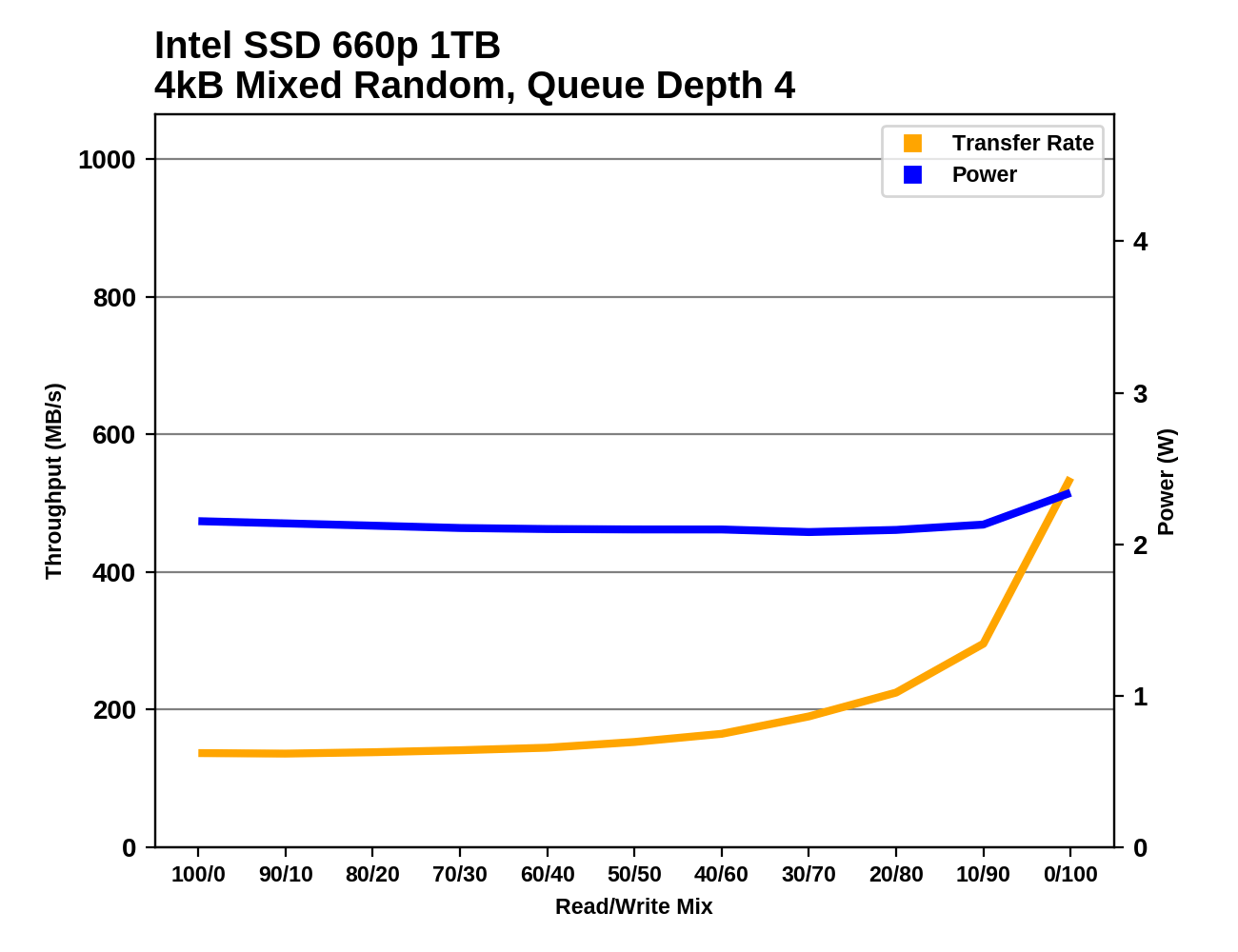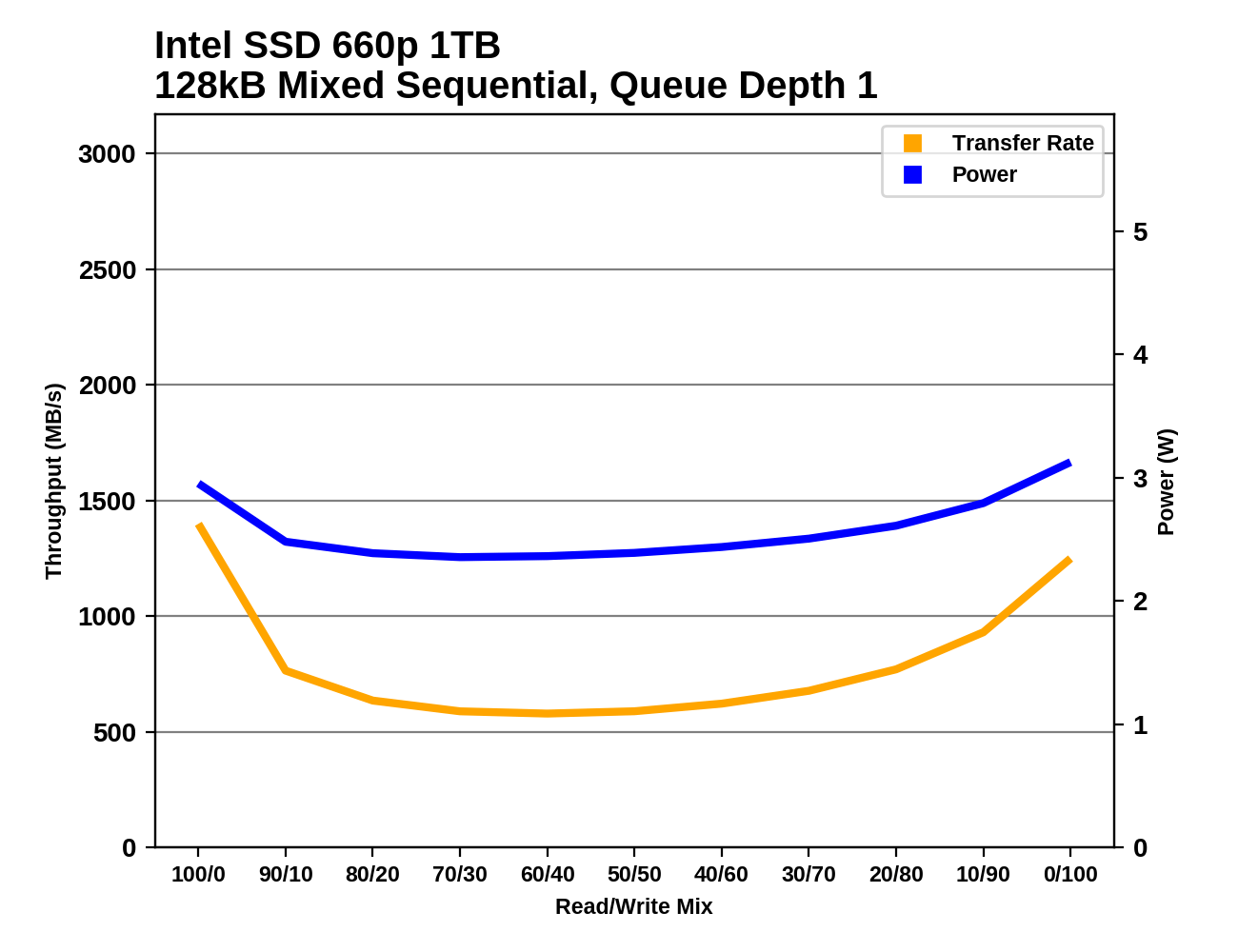The Intel SSD 660p SSD Review: QLC NAND Arrives For Consumer SSDs
by Billy Tallis on August 7, 2018 11:00 AM ESTMixed Random Performance
Our test of mixed random reads and writes covers mixes varying from pure reads to pure writes at 10% increments. Each mix is tested for up to 1 minute or 32GB of data transferred. The test is conducted with a queue depth of 4, and is limited to a 64GB span of the drive. In between each mix, the drive is given idle time of up to one minute so that the overall duty cycle is 50%.

The mixed random I/O performance of the Intel SSD 660p is clearly above the other low-end NVMe drives we've tested, or the Crucial MX500 SATA drive. It scores closer to a mid-range NVMe SSD. After filling the drive, performance is cut in half, leaving it performing near low-end NVMe drives like the Phison E8-based Kingston A1000 and below the MX500.
 |
|||||||||
| Power Efficiency in MB/s/W | Average Power in W | ||||||||
The power efficiency of the 660p during the mixed random I/O test is unimpressive but doesn't stand out as being significantly worse that other low-end NVMe drives even when the test is run on a full drive.
 |
|||||||||
The Intel SSD 660p shows very slow performance growth throughout most of the test, but it picks up speed reasonably well toward the end as the workload shifts toward pure writes, and the SLC cache handles things well. When the drive is full, the reduced capacity of the SLC cache prevents speed from increasing much.
Mixed Sequential Performance
Our test of mixed sequential reads and writes differs from the mixed random I/O test by performing 128kB sequential accesses rather than 4kB accesses at random locations, and the sequential test is conducted at queue depth 1. The range of mixes tested is the same, and the timing and limits on data transfers are also the same as above.

The Intel SSD 660p performs better than other entry-level NVMe SSDs or SATA drives when the mixed sequential I/O test is run on a mostly empty drive with a large SLC cache. After the drive is filled, performance drops down to slightly ahead of the 600p and Crucial MX500.
 |
|||||||||
| Power Efficiency in MB/s/W | Average Power in W | ||||||||
The power efficiency of the Intel SSD 660p during the mixed sequential I/O test is decent when operating entirely out of the SLC cache, and on par with most other low-end NVMe drives when the 660p is full.
 |
|||||||||
When the test is run on a mostly-empty 660p the performance shows a very typical bathtub curve and no sign of the SLC cache running out. When the drive is full, performance decreases steadily as the proportion of writes increases.










86 Comments
View All Comments
southleft - Tuesday, May 14, 2019 - link
SSDs replaced under warranty by the maker can sometimes have a silver lining, so to speak. Some years ago we had an Intel X25 80GB fail. Intel replaced it with a newer model 320 which was basically the same but updated to SATA III. We also had a Sandisk Ultra 120GB fail, and Sandisk replaced it with an Ultra 2. These newer replacement models are still running OK some 6 years later, for what it's worth!chrcoluk - Wednesday, September 25, 2019 - link
I agree, this is more important than hitting embargo date for publishing.Its the content not the date that matters. If it takes a year to do it, then so be it. I never buy hardware on release date, to me that's just stupid.
Oxford Guy - Tuesday, August 7, 2018 - link
People trusted Samsung with the 840 and then, oops...The real rule is verify then trust.
mapesdhs - Wednesday, August 8, 2018 - link
One thing about the 840 EVO issue which was a real pain was trying to find out if the same thing affected the standard 840. In the end my conclusion was yes, but few sites bothered to mention it. Oddly enough, of the many SSDs I have, one of the very few that did die was a standard 840. I never bought an 840 EVO because of the reports that came out, but I have a fair few 840 Pros and a heck of a lot of OCZs.Spunjji - Wednesday, August 8, 2018 - link
It was pretty obvious that the 840 was affected because it used the same NAND as the 840 Evo, just without the caching mode. It was also pretty obvious that Samsung didn't care because it was "old" so they never properly fixed it.OwCH - Wednesday, August 8, 2018 - link
Ryan, I love that you will. It is not easy for the user to find real world data on these things and it is, at least to me, information that I want before making the decision to buy a drive.Looking forward to it!
Thanks!
Solid State Brain - Tuesday, August 7, 2018 - link
The stated write endurance should already factor data retention, if it follows JEDEC specifications (JESD219A). For consumer drives, it should be be when the retention time for freshly stored data drops below 1 year after the SSD is powered off, at 30°C.BurntMyBacon - Wednesday, August 8, 2018 - link
The Samsung 840 EVO would like to have a word with you.eastcoast_pete - Wednesday, August 8, 2018 - link
Yes, it should factor data retention, and it should follow JEDEC specs. The problem is the "should". That doesn't mean it or they do. I found that "Trust but verify" is as important in IT as it is in life. Even the biggest names screw up, at least occasionally.IntenvidiAMD - Tuesday, August 7, 2018 - link
Are there any reviewers that do test that?